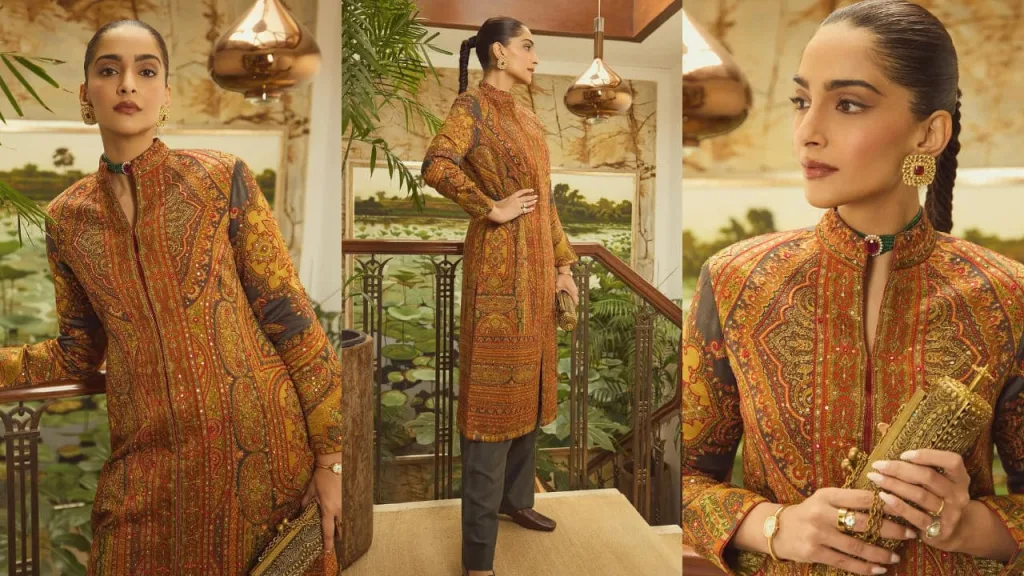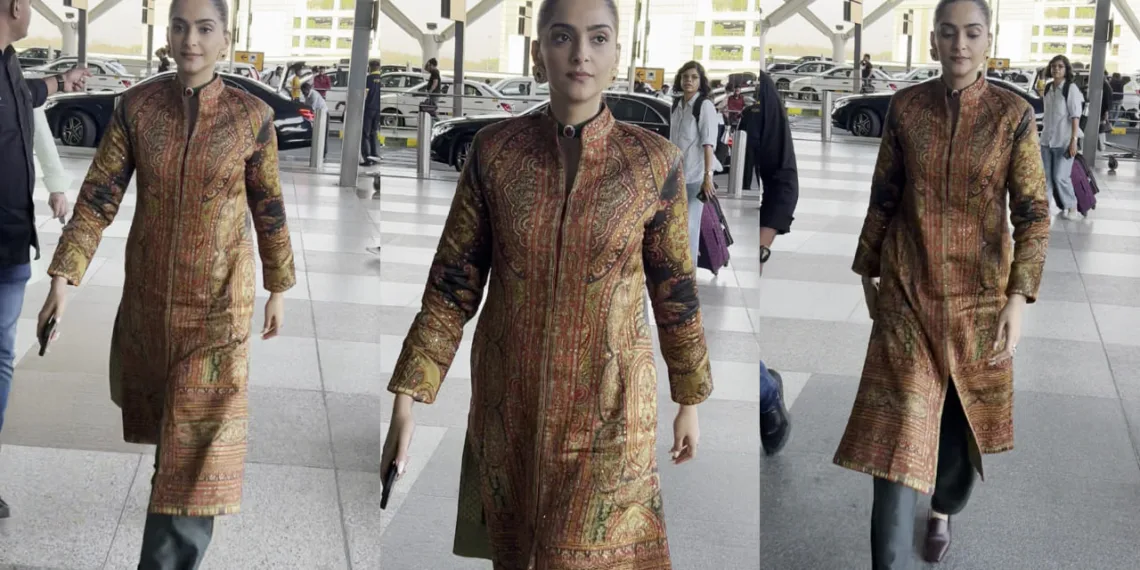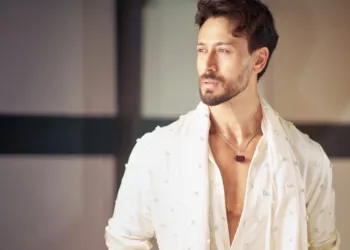In the world of celebrity airport fashion, where comfort often dictates choices of athleisure and casual ensembles, Sonam Kapoor continues to redefine boundaries with her distinctive approach to travel style. The Bollywood fashion maven was recently spotted at the airport making a powerful cultural statement that seamlessly blended heritage luxury with contemporary elegance. Trading predictable travel wear for a richly detailed Kashmiri long coat adorned with intricate tapestry-like designs, Kapoor transformed the terminal concourse into an impromptu runway for cultural appreciation.
Her thoughtfully curated ensemble didn’t merely showcase garments but narrated a story of artistic tradition, elevated by modern styling sensibilities and punctuated with both ancestral jewelry and contemporary luxury accessories. As fellow travelers stared in appreciation and paparazzi cameras flashed, Kapoor demonstrated once again why she remains India’s most fearless fashion icon—one who doesn’t simply follow trends but authoritatively creates them.
Table of Contents
Fusion of Heritage and Luxury: Deconstructing Sonam Kapoor Airport Ensemble
Sonam Kapoor’s airport appearance showcased a masterclass in cultural fusion, centered around a statement Pashmina coat that commanded immediate attention. The Jamawar coat featured symmetric motifs and an arabesque design rendered in a sophisticated palette of burnt red, olive, and dull black—colors that evoked the rich artistic heritage of Kashmir while remaining distinctly modern in their combination. The garment’s thoughtful construction, including its button-up closure, closed collar, and structured boxy shoulders, created a statuesque silhouette that added dramatic presence to Kapoor’s frame while maintaining a sense of refined elegance appropriate for travel.

Rather than pairing this heritage piece with traditional bottoms, Kapoor opted for contemporary flared trousers that created a consistent, elongated silhouette. This deliberate styling choice highlighted her understanding of proportion and balance while demonstrating how cultural garments can be seamlessly integrated into modern wardrobes. The look was grounded with brown leather loafers—a practical yet sophisticated footwear choice that complemented the coat’s earthy tones while providing the comfort necessary for airport navigation.
What elevated this ensemble beyond mere fashion into the realm of artistic expression was Kapoor’s fearless integration of significant jewelry pieces rarely seen in transit settings. The multi-layered emerald beads choker featuring a central opal ruby framed by diamonds would typically be reserved for formal evening events, yet Kapoor confidently incorporated this piece into her travel attire. Her kundan earrings, showcasing intricate jalidar work in gold with central red stones, further enhanced the regal quality of her appearance while creating a cohesive color story with the coat’s palette.
This artistic approach to accessorizing continued with Kapoor’s hair styling—a sleek updo culminating in a fish braid that both showcased her jewelry and added an additional element of traditional craftsmanship to the overall presentation. The deliberately structured hairstyle provided a perfect frame for her face while emphasizing the coat’s elegant collar and shoulder detailing.
Where Tradition Meets Luxury: The Statement Accessories
No Sonam Kapoor fashion moment would be complete without a strategic luxury statement piece, and her airport ensemble was anchored by a coveted Dior tote bag worth Rs 3,20,000. This deliberate pairing of a heritage garment with contemporary luxury created a powerful visual narrative about the evolution of status symbols across cultures and eras. The substantial investment piece functioned not merely as a travel necessity but as a counterpoint to the traditional craftsmanship displayed in her clothing and jewelry.
The Dior bag’s clean, modern lines and recognizable branding created an intriguing tension with the intricate, centuries-old techniques showcased in her Kashmiri coat and kundan jewelry. This juxtaposition highlighted Kapoor’s sophisticated understanding of how luxury is expressed across different cultural contexts and time periods. Rather than allowing these different expressions to compete, her styling created a harmonious dialogue between them.
What makes Kapoor’s approach to airport fashion particularly noteworthy is her willingness to transcend conventional boundaries between casual travel wear and formal cultural attire. While most celebrities reserve heritage pieces for ceremonial occasions or cultural events, Kapoor consistently integrates these elements into everyday contexts, effectively democratizing access to cultural appreciation while elevating the mundane activity of travel into an opportunity for artistic expression.
| Element | Description | Estimated Value | Cultural Significance |
|---|---|---|---|
| Kashmiri Long Coat | Jamawar Pashmina with arabesque designs in burnt red, olive and black | ₹1,50,000+ | Represents centuries of Kashmir’s textile heritage |
| Flared Trousers | Modern cut in complementary neutral tone | ₹35,000+ | Contemporary silhouette creating fusion look |
| Kundan Earrings | Jalidar work in gold with center red stone | ₹75,000+ | Traditional Indian craftsmanship dating back to Mughal era |
| Emerald Beads Choker | Multi-layered with opal ruby center framed by diamonds | ₹2,00,000+ | Reflects royal jewelry traditions of India |
| Dior Tote Bag | Contemporary luxury accessory | ₹3,20,000 | Symbol of modern international luxury |
| Brown Leather Loafers | Classic design in rich brown leather | ₹50,000+ | Practical yet sophisticated European footwear tradition |
The Impact: Setting New Standards for Airport Fashion
Sonam Kapoor’s distinctive airport appearance represents more than an individual style moment—it signals a broader shift in how cultural garments are being reclaimed and repositioned in contemporary fashion contexts. By choosing a Kashmiri long coat for travel rather than reserving it for formal cultural occasions, Kapoor challenges conventional categorizations of ethnic wear while creating valuable visibility for traditional craftsmanship in unexpected settings.
This particular style statement arrives at a meaningful moment in fashion’s ongoing conversation about cultural appreciation versus appropriation. Kapoor’s approach—wearing a garment from her own cultural heritage while thoughtfully integrating it into a contemporary context—offers a masterclass in respectful cultural celebration. The choice highlights the remarkable craftsmanship of Kashmiri textiles while demonstrating their continued relevance in modern wardrobes.

Fashion industry observers note that Kapoor’s consistent championing of Indian craftsmanship has tangible market impacts. Designers and brands focusing on traditional techniques often report increased interest following her public appearances in their pieces. By positioning heritage garments alongside international luxury brands like Dior, she elevates their perceived value and desirability on the global stage.
Beyond the material impacts, Kapoor’s approach to fashion serves as inspiration for a generation of style enthusiasts seeking to incorporate cultural elements into everyday wardrobes without falling into costume territory. Her airport ensemble demonstrates how traditional pieces can be styled for practical modern contexts while maintaining their distinctive character and cultural significance.
Ananya Panday Stuns in Anamika Khanna’s Tribal-Chic Ensemble at Lakmé Fashion Week 2025
Frequently Asked Questions
What is the significance of a Jamawar Kashmiri coat, and why is it considered a luxury item?
Jamawar coats represent one of Kashmir’s most prestigious textile traditions, with historical and cultural significance that extends back several centuries. Originally, authentic Jamawar was a type of shawl woven from delicate Pashmina wool using an extremely labor-intensive technique that could take artisans years to complete a single piece. The term “Jamawar” derives from “jama” (robe) and “war” (yard), referring to the fabric’s original purpose for making royal garments. What makes these coats particularly valuable is the intricate handwork involved—traditional pieces feature complex patterns created using a twill tapestry technique where skilled craftsmen interweave colorful threads to form detailed motifs including the distinctive paisley and floral designs.
During the Mughal era (16th-19th centuries), these textiles were so precious that they were exchanged as diplomatic gifts and considered among the most valuable possessions of nobility. Modern Jamawar coats, like the one worn by Sonam Kapoor, typically cost between ₹1-3 lakh depending on the quality of materials, intricacy of design, and authenticity of craftsmanship. Beyond their monetary value, these garments represent a living cultural heritage and support communities of skilled artisans in Kashmir who maintain these traditional techniques despite economic challenges and changing market demands.
How does Sonam Kapoor’s airport style differ from other Bollywood celebrities, and what makes her a fashion influencer?
Sonam Kapoor’s airport style stands apart from her Bollywood contemporaries through her willingness to transcend conventional travel wear boundaries and her deliberate cultural statements. While most celebrities opt for comfortable athleisure, designer tracksuits, or casual luxury brands for travel, Kapoor regularly incorporates heritage pieces, formal silhouettes, and significant jewelry that would typically be reserved for red carpet events. This fearlessness extends to her practical choices—where others prioritize comfort above all, Kapoor demonstrates that sophisticated styling can coexist with functionality. What truly distinguishes her as a fashion influencer is her innovative contextual placement of garments—whether wearing traditional Indian craftsmanship in international settings or incorporating cultural pieces into everyday scenarios.
Unlike celebrities who simply showcase expensive brands, Kapoor’s fashion narratives frequently highlight lesser-known designers, traditional craftsmanship, and thoughtful styling techniques accessible to those without unlimited budgets. Fashion analysts credit Kapoor with meaningfully impacting the industry through her authenticity and risk-taking approach—her willingness to embrace unconventional styling, support emerging designers, and champion Indian craftsmanship has expanded the conversation around fashion in India beyond western-centric luxury. Her influence is perhaps best measured by how frequently her looks generate discussions about the boundaries of appropriate contexts for different garment types, ultimately reshaping conventions around when and where specific fashion elements can be worn.








